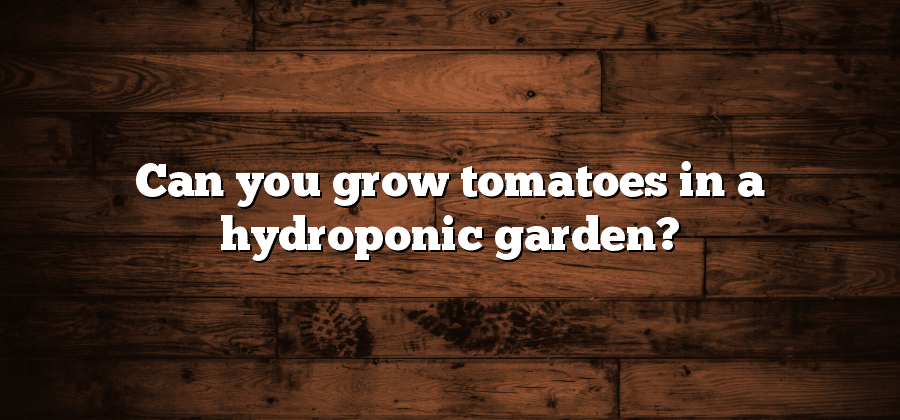Benefits of Hydroponic Gardening for Tomatoes
Hydroponic gardening offers numerous benefits for cultivating healthy and productive tomato plants. One of the main advantages is the ability to control and optimize the growing environment. Unlike traditional soil-based gardening, hydroponics allows for precise management of water, nutrients, and light, ensuring that the tomatoes receive the optimal conditions for growth. This control over environmental factors results in faster growth, higher yields, and better overall quality of the tomatoes.
Additionally, hydroponic gardening eliminates the risk of soil-borne diseases and pests that can plague traditional tomato cultivation. Since hydroponic systems do not rely on soil, there is no chance of soil-borne pathogens or pests infecting the plants. This drastically reduces the need for pesticides and fungicides, making hydroponic tomatoes healthier and safer for consumption. Furthermore, the absence of soil also means less weeding and less physical labor required, making hydroponic gardening a more convenient and efficient method for growing tomatoes.
Necessary Equipment for Growing Tomatoes Hydroponically
When it comes to growing tomatoes hydroponically, having the right equipment is essential for success. One of the most important pieces of equipment is a hydroponic system, which provides the necessary support and environment for the plants to grow and thrive. There are several types of hydroponic systems available, such as nutrient film technique (NFT), deep water culture (DWC), and drip irrigation. Each system has its advantages and disadvantages, so it’s important to choose one that best fits your needs and gardening space.
In addition to a hydroponic system, other necessary equipment includes grow lights, timers, and pH meters. Grow lights are used to provide the plants with artificial light, simulating sunlight for proper photosynthesis. Timers are essential for controlling the lighting and watering schedules, ensuring that the plants receive the right amount of light and nutrients at the appropriate times. pH meters are crucial for monitoring the acidity or alkalinity of the nutrient solution, as tomatoes thrive in a slightly acidic pH range of 5.5 to 6.5. By regularly testing and adjusting the pH levels, you can ensure that your tomato plants are getting the nutrients they need to grow healthy and produce high yields.
Choosing the Right Tomato Varieties for Hydroponic Gardening
When it comes to hydroponic gardening, choosing the right tomato varieties is crucial for a successful harvest. While there are numerous tomato varieties available, not all of them are optimal for hydroponic systems. In order to maximize your yields and ensure the best quality tomatoes, it is important to select varieties that are well-suited for this growing method.
One of the key factors to consider when choosing tomato varieties for hydroponic gardening is their growth habit. Indeterminate varieties, which continue to grow and produce fruit throughout the season, are often preferred for hydroponic systems. These varieties can be trained to grow vertically, making efficient use of the available space in your hydroponic setup. Determinate varieties, on the other hand, have a more compact growth habit and tend to produce their fruit all at once. While determinate tomatoes can still be grown hydroponically, they may require additional support or pruning to ensure proper growth and development.
Creating the Ideal Growing Environment for Hydroponic Tomatoes
Creating the ideal growing environment is crucial for the success of hydroponic tomato plants. One important factor to consider is the temperature. Tomatoes thrive best in a temperature range of 70-85°F (21-29°C). It is essential to maintain a consistent temperature throughout the day and night to avoid any stress on the plants. This can be achieved by using proper insulation, ventilation systems, and temperature control devices.
In addition to temperature, lighting plays a vital role in hydroponic tomato cultivation. Tomatoes require at least 10-12 hours of direct light each day to promote healthy growth and fruit development. It is recommended to use high-intensity discharge (HID) lights, such as metal halide or high-pressure sodium lamps, as they provide the necessary intensity and spectrum for optimal plant growth. Adequate spacing and height adjustment of the lights are also crucial to ensure uniform light distribution and prevent any shading issues.
By creating the ideal growing environment with proper temperature control and adequate lighting, hydroponic tomato growers can provide their plants with the ideal conditions for healthy growth and higher yields. However, it is also important to pay attention to other factors such as humidity, air circulation, and carbon dioxide levels to further maximize the potential of hydroponic tomato production.
The Importance of Proper Nutrient Solution for Hydroponic Tomato Plants
Hydroponic gardening offers a precise and controlled method of growing tomatoes, and one of the key factors in ensuring successful growth is providing the plants with the proper nutrient solution. Unlike traditional soil-based gardening, where nutrients are naturally present in the soil, hydroponic systems require an artificial nutrient solution to supply the plants with the necessary elements for healthy growth.
The nutrient solution used in hydroponic tomato cultivation must contain a balanced combination of essential macronutrients, such as nitrogen, phosphorus, and potassium, as well as micronutrients like iron, manganese, and zinc. These nutrients are crucial for various plant functions, including photosynthesis, root development, and fruit production. A well-formulated nutrient solution ensures that the tomato plants receive all the necessary elements in the right proportions, leading to vigorous growth, increased fruit yields, and enhanced flavor.






